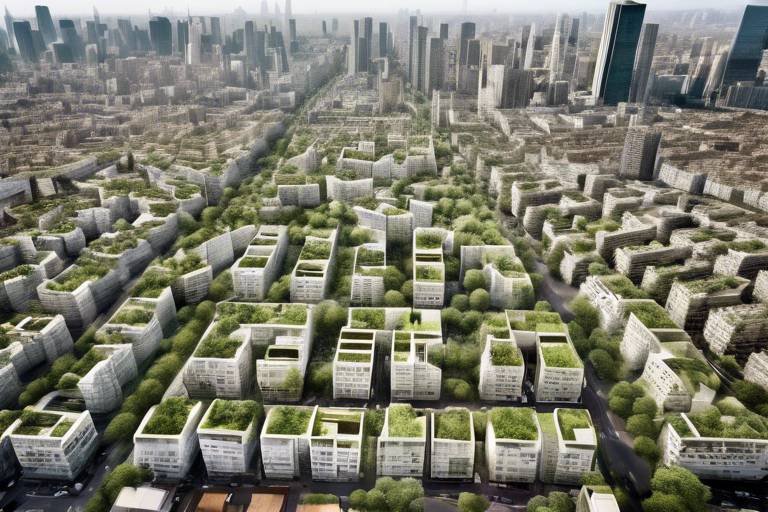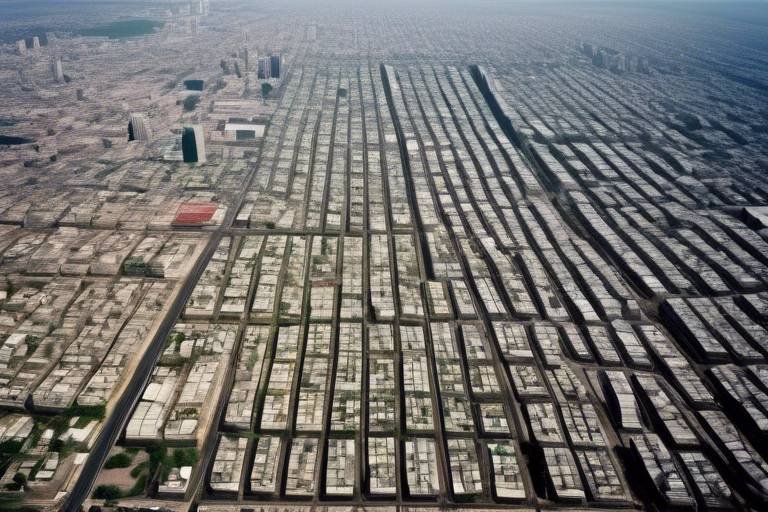How to Develop an Urban Sustainability Plan?
Creating an effective urban sustainability plan is not just a task; it’s a journey toward a brighter, more resilient future for our cities. As urban populations continue to grow, the need for sustainable practices becomes increasingly critical. But how do we embark on this journey? The key lies in understanding that urban sustainability is not merely about environmental conservation; it encompasses a holistic approach that integrates environmental health, social equity, and economic vitality. This article will guide you through the essential components and strategies necessary for developing a robust urban sustainability plan.
At its core, urban sustainability is about creating cities that cater to the needs of the present without jeopardizing the ability of future generations to meet their own needs. Think of it like planting a tree: you want it to grow strong and healthy, providing shade and fruit for years to come. Urban sustainability focuses on the balance between ecological health, social equity, and economic vitality. It’s about creating communities where everyone has access to resources and opportunities while ensuring that our planet remains healthy. This means integrating sustainable practices into every aspect of urban planning, from transportation to waste management, and everything in between.
The first step in developing a sustainability plan is to conduct a thorough assessment of the current urban conditions. This involves evaluating existing infrastructure, resource consumption patterns, and social dynamics. Imagine trying to fix a car without knowing what’s wrong with it; similarly, without a clear picture of your urban environment, it’s impossible to identify areas needing improvement or opportunities for sustainable practices.
Collecting data is essential for understanding the current state of your urban area. Various methods can be employed, including:
- Surveys: Engaging residents to gather their insights and experiences.
- Environmental Assessments: Evaluating local ecosystems and resource usage.
- Community Feedback: Hosting workshops and forums to discuss sustainability issues.
This information is invaluable for informed decision-making and helps prioritize sustainability initiatives that resonate with the community's needs.
Engaging the community in the data collection process fosters collaboration and inclusivity. When residents feel their voices are heard, they become more invested in the outcomes. Think of it as building a house; you wouldn’t want to do it without consulting those who will live in it! Community engagement leads to a more comprehensive sustainability plan that reflects diverse perspectives and needs.
In today’s digital age, leveraging technology can significantly enhance the assessment process. Tools such as Geographic Information Systems (GIS) and data analytics provide valuable insights into urban dynamics. For example, GIS can help visualize data trends related to land use, demographics, and environmental conditions, which facilitates informed planning decisions. Imagine having a map that not only shows you where you are but also highlights the best routes to take for achieving your sustainability goals!
Once you’ve assessed current conditions, the next step is to set clear sustainability goals. These goals should align with broader environmental, social, and economic objectives. Think of these goals as the compass guiding your urban planning efforts. For instance, you might aim to reduce carbon emissions by a certain percentage, increase green spaces, or enhance public transportation accessibility. The clearer your goals, the easier it will be to develop actionable strategies.
An effective action plan is essential for translating goals into reality. This plan should outline specific initiatives, timelines, and responsible parties to ensure accountability throughout the implementation process. It’s like a recipe: if you want to bake a cake, you need to know the ingredients and the steps to follow!
Determining the necessary resources, including funding, personnel, and materials, is critical for successful plan implementation. Without proper resource allocation, even the best-laid plans can fall flat. It’s crucial to ensure that initiatives are adequately supported and can achieve their intended outcomes. Imagine trying to build a bridge with no materials; it simply won’t work!
Finally, establishing a framework for monitoring and evaluating progress is vital. This helps assess the effectiveness of sustainability initiatives and allows for adjustments based on real-time data and community feedback. Think of it as checking your GPS while on a road trip; if you’re off course, you can recalibrate your route to reach your destination more efficiently.
Q: What is urban sustainability?
A: Urban sustainability refers to creating cities that meet present needs without compromising future generations, focusing on ecological health, social equity, and economic vitality.
Q: Why is community engagement important in sustainability planning?
A: Community engagement ensures diverse perspectives are included, fostering collaboration and increasing the likelihood of successful outcomes.
Q: How can technology aid in developing a sustainability plan?
A: Technology, such as GIS and data analytics, provides valuable insights into urban dynamics, helping inform planning decisions and strategies.

Understanding Urban Sustainability
Urban sustainability is more than just a buzzword; it's a vital framework for the future of our cities. It's all about crafting urban environments that not only meet the needs of the present but also safeguard the interests of future generations. Imagine a city that thrives on ecological health, promotes social equity, and ensures economic vitality. This is the essence of urban sustainability, where every decision made today is a step towards a brighter, more sustainable tomorrow.
At its core, urban sustainability integrates three key pillars: environmental integrity, social equity, and economic prosperity. These components work together like a well-oiled machine, ensuring that urban development is balanced and holistic. When we talk about environmental integrity, we're referring to the necessity of preserving our natural resources and ecosystems. This means reducing pollution, conserving water, and promoting biodiversity within urban settings.
On the social front, urban sustainability emphasizes the importance of social equity. It advocates for inclusive policies that ensure all community members have access to essential services, such as transportation, healthcare, and education. Think of it as building a community where everyone has a seat at the table, where diverse voices are heard, and where no one is left behind.
Lastly, there’s the economic aspect. Urban sustainability promotes economic vitality through sustainable job creation, local business support, and innovative economic practices. It’s about creating a thriving economy that respects the environment and uplifts communities. This is where the magic happens—when cities harness their unique assets and foster environments where businesses can flourish while maintaining a commitment to sustainability.
Understanding urban sustainability also involves recognizing the interconnectedness of these pillars. For instance, a city that invests in green spaces not only enhances environmental quality but also improves the well-being of its residents, leading to healthier communities and potentially lower healthcare costs. Similarly, sustainable economic practices can lead to job creation, which in turn supports social equity by providing opportunities for all.
As we move forward, it’s essential to consider how urban sustainability can be woven into the fabric of city planning. This means engaging stakeholders at every level—from government officials and urban planners to community members and businesses. By fostering collaboration, cities can create comprehensive sustainability plans that reflect the needs and aspirations of their residents.
In summary, urban sustainability is a multifaceted approach that requires a deep understanding of the intricate relationships between environmental health, social equity, and economic vitality. By prioritizing these elements, cities can pave the way for a sustainable future that benefits everyone. So, let’s dive deeper into how we can assess current urban conditions and identify the key sustainability goals that will guide our efforts!

Assessing Current Urban Conditions
When it comes to developing an effective urban sustainability plan, assessing the current urban conditions is not just important; it's absolutely crucial. Think of it as a health check-up for your city. Just like a doctor needs to understand your medical history to provide the best treatment, urban planners must evaluate existing infrastructure, resource consumption, and social dynamics to identify areas that need improvement. This assessment serves as the foundation for any sustainability initiatives, ensuring that they are relevant and impactful.
To kick off this assessment, various data collection methods can be employed. Surveys can capture the sentiments and needs of the community, while environmental assessments can highlight areas that are under stress or in need of intervention. Additionally, community feedback serves as a goldmine of information, providing insights that may not be obvious through data alone. Think of it as crowdsourcing wisdom from those who live and breathe the urban environment every day.
There are several effective methods for collecting data to assess urban conditions:
- Surveys: Conducting surveys can help gather valuable information from residents about their experiences and perceptions of urban living.
- Environmental Assessments: These assessments evaluate the current state of natural resources, air quality, and green spaces.
- Community Feedback: Engaging with residents through public forums or social media can unearth unique perspectives and suggestions.
By employing these methods, urban planners can build a comprehensive picture of the current conditions. But it doesn't stop there; engaging the community in this process is equally important. When residents feel involved, they are more likely to support and contribute to sustainability efforts. This community engagement not only enriches the data collected but also fosters a sense of ownership among the residents.
One effective way to engage the community is through workshops or town hall meetings where residents can voice their opinions and share their experiences. This collaborative approach not only builds trust but also ensures that diverse perspectives are included in the planning process. Imagine a potluck dinner where everyone brings a dish; the more variety you have, the richer the meal becomes. Similarly, incorporating different viewpoints leads to a more robust sustainability plan.
In today's digital age, leveraging technology can significantly enhance the assessment process. Geographic Information Systems (GIS) and data analytics tools provide valuable insights into urban dynamics, helping planners visualize data in a way that highlights trends and issues. For example, GIS can map out areas with high pollution levels or insufficient green spaces, making it easier to prioritize interventions. This technological integration not only streamlines the assessment but also empowers planners to make informed decisions based on real-time data.
In conclusion, assessing current urban conditions is like laying the groundwork for a solid building. Without a thorough understanding of the existing landscape—both physical and social—any sustainability plan risks becoming ineffective or irrelevant. By combining various data collection methods, engaging the community, and utilizing technology, urban planners can create a comprehensive assessment that serves as the backbone for future sustainability initiatives.
Q: Why is assessing current urban conditions important?
A: It helps identify areas needing improvement and opportunities for sustainable practices, ensuring that initiatives are relevant and effective.
Q: What methods can be used to collect data?
A: Surveys, environmental assessments, and community feedback are effective methods for gathering valuable information about urban conditions.
Q: How can technology aid in assessing urban conditions?
A: Tools like GIS and data analytics provide insights that help visualize data trends, making it easier to identify issues and prioritize interventions.

Data Collection Methods
In the quest to develop an effective urban sustainability plan, data collection serves as the backbone of informed decision-making. Without accurate and comprehensive data, any sustainability initiative risks being misguided or ineffective. So, how do we gather this crucial information? There are several methods to consider, each with its own strengths and weaknesses.
First off, surveys can be an incredibly powerful tool. By reaching out to residents and stakeholders, cities can gain insights into community needs, preferences, and behaviors. Imagine a city-wide survey asking residents about their transportation habits or their views on green spaces. The responses can illuminate areas that require immediate attention or highlight initiatives that would be well-received. However, it's essential to ensure that surveys are designed to be inclusive and accessible, allowing all voices to be heard.
Next, we have environmental assessments. These assessments involve a thorough evaluation of the current state of urban ecosystems, including air and water quality, biodiversity, and land use. For instance, by analyzing pollution levels in various neighborhoods, city planners can identify hotspots that require urgent intervention. This method not only provides a snapshot of current conditions but also helps in predicting future trends based on current data.
Additionally, community feedback is invaluable. Hosting public forums or workshops allows citizens to express their concerns and ideas directly. These gatherings foster a sense of ownership and collaboration, making residents feel like active participants in shaping their environment. When communities are engaged, the data collected becomes richer and more nuanced, reflecting the diverse perspectives of the population.
To further enhance the data collection process, leveraging technology can be a game-changer. Geographic Information Systems (GIS) and data analytics tools can transform raw data into visual representations, making it easier to identify patterns and trends. For example, GIS can help visualize areas of high foot traffic or identify regions with inadequate green spaces. This technological approach not only streamlines data collection but also aids in presenting findings to stakeholders in an easily digestible format.
In summary, employing a mix of surveys, environmental assessments, community feedback, and advanced technology can create a robust framework for data collection. By integrating these methods, urban planners can gather a comprehensive understanding of current conditions, ultimately paving the way for a more sustainable urban future.
- What is the importance of data collection in urban sustainability?
Data collection is vital as it provides the necessary insights for informed decision-making, helping to identify areas that need improvement and opportunities for sustainable practices. - How can technology aid in data collection?
Technology, such as GIS and data analytics, can enhance data collection by visualizing information and identifying patterns that may not be apparent through traditional methods. - Why is community feedback important?
Community feedback ensures that diverse perspectives are included in the planning process, fostering collaboration and a sense of ownership among residents.

Community Engagement Strategies
Community engagement is the heartbeat of any successful urban sustainability plan. Without the active participation of residents, even the most meticulously crafted strategies can fall flat. So, how do we ensure that community voices are not just heard, but truly valued? First and foremost, it’s essential to create a welcoming environment where everyone feels comfortable sharing their thoughts and ideas. This could mean hosting informal gatherings in local parks or community centers, where residents can engage in open dialogue about their needs and aspirations.
Another effective strategy is to leverage digital platforms for outreach. Social media, community forums, and dedicated websites can serve as powerful tools to gather input and disseminate information. Imagine a vibrant online community where residents can post their suggestions, vote on proposed initiatives, and even participate in virtual town halls. This not only broadens the reach but also allows for diverse perspectives, especially from those who may not be able to attend in-person meetings.
Furthermore, consider implementing workshops and focus groups that bring together different segments of the community. By facilitating discussions among various stakeholders—be it local businesses, schools, or environmental groups—you can foster collaboration and identify shared goals. These sessions can be structured around specific themes, such as waste management or green spaces, to dive deeper into pressing issues. For instance, a workshop on urban gardening could not only educate participants but also encourage them to take ownership of their local environment.
Lastly, it’s crucial to provide feedback on how community input has influenced the planning process. When residents see their ideas reflected in the sustainability plan, it builds trust and encourages ongoing participation. This could be achieved through regular updates via newsletters or community meetings, where progress is shared, and new opportunities for engagement are presented. By closing the feedback loop, you reinforce the idea that every voice matters, and together, you can create a more sustainable future.
| Engagement Strategy | Description | Benefits |
|---|---|---|
| Informal Gatherings | Casual meetups in community spaces to discuss sustainability. | Fosters open dialogue and builds community trust. |
| Digital Platforms | Utilizing social media and forums for gathering input. | Increases outreach and includes diverse voices. |
| Workshops & Focus Groups | Targeted discussions on specific sustainability topics. | Encourages collaboration and in-depth exploration of issues. |
| Feedback Mechanisms | Regular updates on how community input shapes plans. | Builds trust and encourages ongoing participation. |

Utilizing Technology and Tools
In today's fast-paced world, technology and innovative tools play a pivotal role in shaping urban sustainability plans. Imagine trying to navigate a bustling city without a map or GPS; it would be chaotic and inefficient, right? Similarly, urban planners can harness various technologies to enhance their decision-making processes and streamline their sustainability initiatives. By integrating tools like Geographic Information Systems (GIS) and data analytics, cities can visualize complex data sets, identify trends, and make informed choices that align with sustainability goals.
GIS technology, for example, allows urban planners to create detailed maps that illustrate everything from green spaces to transportation networks. This visual representation is not just pretty; it provides invaluable insights into how different elements of the city interact with one another. For instance, planners can analyze how proximity to parks affects community health or how public transit routes can be optimized to reduce carbon emissions. The beauty of GIS lies in its ability to layer multiple data points, giving a comprehensive view of urban dynamics.
Moreover, data analytics tools can sift through vast amounts of information, uncovering patterns that might not be immediately obvious. By analyzing data related to energy consumption, waste management, and traffic patterns, cities can pinpoint areas where improvements are needed. For instance, if data reveals that certain neighborhoods are consuming more energy than others, targeted initiatives can be developed to promote energy efficiency in those areas. This proactive approach not only conserves resources but also fosters a sense of community involvement in sustainability efforts.
Another exciting frontier in urban sustainability is the use of smart technology. Smart sensors can monitor air quality, traffic flow, and even energy usage in real-time. This data can then be used to implement immediate changes, such as adjusting traffic signals to reduce congestion or alerting residents about poor air quality days. It's like having a personal assistant for the city, constantly working to optimize urban living conditions.
To further illustrate the impact of technology on urban sustainability, consider the following table that outlines various tools and their applications:
| Technology/Tool | Application |
|---|---|
| Geographic Information Systems (GIS) | Mapping urban features, analyzing land use, and planning infrastructure. |
| Data Analytics | Identifying consumption patterns, assessing resource efficiency, and forecasting needs. |
| Smart Sensors | Monitoring environmental conditions, traffic patterns, and energy usage. |
| Mobile Apps | Engaging citizens in sustainability initiatives and providing real-time information. |
In conclusion, leveraging technology and tools is not just a luxury; it's a necessity for cities aiming to create robust urban sustainability plans. By embracing these innovations, urban planners can foster a collaborative environment where data-driven decisions lead to a healthier, more sustainable future for all. So, the next time you think about urban planning, remember that technology is your ally in crafting a city that thrives today and for generations to come.
- What is the role of technology in urban sustainability? Technology helps urban planners analyze data, visualize urban dynamics, and implement effective sustainability initiatives.
- How can GIS be used in urban planning? GIS allows planners to create detailed maps that reveal relationships between different urban elements, aiding in informed decision-making.
- What are smart sensors? Smart sensors are devices that monitor various urban conditions in real-time, providing data that can enhance city management and sustainability efforts.
- Why is community engagement important in utilizing technology? Engaging the community ensures diverse perspectives are considered, leading to more comprehensive and effective sustainability plans.

Identifying Key Sustainability Goals
Identifying key sustainability goals is like drawing a roadmap for a long journey; it guides us toward a destination that not only benefits the present but also secures a brighter future for generations to come. These goals should be clear, measurable, and aligned with the broader objectives of environmental, social, and economic sustainability. Imagine a world where clean air, green spaces, and vibrant communities thrive together—this is the vision we strive to achieve through effective urban planning.
To start, we must first understand that sustainability is not a one-size-fits-all concept. Each urban environment has its unique challenges and opportunities. Therefore, engaging various stakeholders—including local governments, businesses, and community members—is crucial. By doing so, we can ensure that the goals we set reflect the needs and aspirations of the community. For instance, a city facing high pollution levels might prioritize goals related to reducing emissions and enhancing public transportation.
Here are some common sustainability goals that cities often consider:
- Reducing Carbon Footprint: Implementing measures to lower greenhouse gas emissions through renewable energy sources and energy-efficient practices.
- Enhancing Green Spaces: Increasing parks, gardens, and urban forests to improve air quality and provide recreational areas for residents.
- Promoting Social Equity: Ensuring that all community members have access to essential services, housing, and opportunities.
- Encouraging Economic Resilience: Supporting local businesses and creating job opportunities that align with sustainability principles.
These goals should be categorized into short-term and long-term objectives. Short-term goals might focus on immediate actions, such as launching a recycling program or organizing community clean-up events. Long-term goals, on the other hand, could involve comprehensive changes like transitioning to renewable energy sources or developing sustainable public transportation systems.
Furthermore, it's essential to incorporate SMART criteria—Specific, Measurable, Achievable, Relevant, and Time-bound—when formulating these goals. This approach ensures that the goals are not only aspirational but also realistic and actionable. For example, instead of stating, "We want to improve air quality," a SMART goal would be, "We aim to reduce particulate matter levels by 30% within the next five years." This specificity allows for better tracking of progress and accountability.
Lastly, ongoing community engagement is vital in the goal-setting process. Regular feedback sessions, surveys, and public forums can help refine these goals and ensure they remain relevant as circumstances change. Remember, sustainability is a journey, not a destination; it requires continuous adaptation and collaboration. By identifying key sustainability goals, we lay the foundation for a resilient urban future that balances ecological health, social equity, and economic vitality.
1. What are sustainability goals?
Sustainability goals are specific objectives aimed at promoting environmental health, social equity, and economic viability within urban settings. They guide cities in their efforts to create a more sustainable future.
2. How can communities get involved in setting sustainability goals?
Communities can participate through public forums, surveys, and workshops that allow residents to voice their concerns and aspirations. This engagement ensures that the goals reflect the diverse needs of the population.
3. Why is it important to have measurable goals?
Measurable goals allow cities to track progress, assess the effectiveness of initiatives, and make necessary adjustments based on real-time data, ensuring accountability and transparency in the sustainability process.

Creating an Action Plan
When it comes to implementing an urban sustainability plan, creating an action plan is like drawing a roadmap to your destination. You wouldn't set out on a road trip without knowing where you're headed, right? Similarly, an action plan outlines the specific steps needed to turn sustainability goals into reality. It serves as a guide, ensuring that every initiative is strategically aligned with the overarching vision of a sustainable urban environment.
The first step in crafting a robust action plan is to clearly define the initiatives that will drive your sustainability goals forward. These initiatives should be diverse, addressing various aspects of urban life, such as energy efficiency, waste reduction, and community engagement. For instance, you might consider initiatives like:
- Green Infrastructure: Implementing parks, green roofs, and urban gardens to enhance biodiversity and improve air quality.
- Public Transportation Enhancements: Expanding and promoting public transit options to reduce reliance on personal vehicles.
- Renewable Energy Projects: Investing in solar panels or wind turbines to power municipal buildings sustainably.
Next, it's crucial to establish timelines for each initiative. A timeline creates a sense of urgency and helps keep everyone accountable. It’s like setting deadlines for a school project; without them, it’s easy to procrastinate. For example, you might set a goal to complete the installation of solar panels within two years, while community engagement initiatives could roll out over several months. By breaking down the larger goals into manageable timeframes, you make the process less daunting and more achievable.
Moreover, assigning responsible parties for each initiative is essential. Who will be in charge of overseeing the implementation? Will it be a city department, a community organization, or a collaboration of both? Clearly defined roles ensure that everyone knows their responsibilities, which is vital for maintaining momentum. Consider creating a table to outline these roles:
| Initiative | Responsible Party | Timeline |
|---|---|---|
| Green Infrastructure | Urban Planning Department | 2023-2025 |
| Public Transportation Enhancements | Transit Authority | 2023-2024 |
| Renewable Energy Projects | Energy Commission | 2024-2026 |
In addition to defining initiatives, timelines, and responsible parties, it’s important to consider resource allocation. Think of resources as the fuel for your sustainability engine. Without adequate funding, personnel, and materials, even the best-laid plans can stall. Identify what resources are necessary for each initiative and secure them early in the planning process. This proactive approach can save time and prevent roadblocks later on.
Finally, remember that an action plan is not set in stone. It should be a living document that evolves as you monitor and evaluate the progress of your sustainability initiatives. Establishing a framework for monitoring and evaluation allows you to track success and make adjustments as needed. This is crucial because, just like in life, not every plan works out perfectly on the first try. Incorporating feedback from the community and stakeholders can provide valuable insights that help refine your strategies over time.
In conclusion, creating an action plan is a vital step in the urban sustainability journey. By defining initiatives, setting timelines, assigning responsibilities, allocating resources, and establishing a monitoring framework, you can ensure that your sustainability goals are not just dreams but achievable realities. So, are you ready to roll up your sleeves and get started?
Q1: What is the first step in creating an urban sustainability action plan?
A1: The first step is to clearly define your sustainability initiatives that align with your overall goals.
Q2: How important is community engagement in the action plan?
A2: Community engagement is crucial as it ensures diverse perspectives are included, fostering collaboration and support for the initiatives.
Q3: Can the action plan be modified after it's created?
A3: Yes, the action plan should be a living document that evolves based on monitoring and community feedback.

Resource Allocation
Resource allocation is the backbone of any successful urban sustainability plan. Imagine trying to build a house without knowing how many bricks you have or how much cement you need. It’s similar when it comes to implementing sustainability initiatives; without a clear understanding of the necessary resources, your plans could easily crumble. Effective resource allocation ensures that each initiative is not just a lofty idea but a tangible reality that can be executed on the ground.
To begin with, it’s essential to identify the types of resources required for your sustainability initiatives. These typically fall into several categories:
- Financial Resources: Funding is often the most critical component. This can come from various sources, including government grants, private investments, and community fundraising efforts.
- Human Resources: Skilled personnel are vital. Engaging experts in urban planning, environmental science, and community engagement can significantly enhance the quality of your initiatives.
- Material Resources: This includes everything from construction materials for green buildings to technology for smart city solutions.
Once you’ve identified these resources, the next step is to prioritize them based on the urgency and impact of each initiative. Think of it like planning a road trip; you wouldn’t pack your bags without knowing your destination and the route you’ll take. Similarly, establishing a hierarchy of needs will guide your allocation process. For instance, if reducing carbon emissions is a pressing goal, you might allocate more funds and personnel to initiatives focused on renewable energy sources.
Furthermore, it’s crucial to create a detailed budget that outlines how funds will be spent. This budget should include a breakdown of costs associated with each initiative, allowing for transparency and accountability. A well-structured budget can also help in securing funding, as potential investors or grant providers often require a clear financial plan.
Here’s a simple table that illustrates how you might break down resource allocation for three hypothetical sustainability initiatives:
| Initiative | Financial Resources ($) | Human Resources (Hours) | Material Resources |
|---|---|---|---|
| Solar Panel Installation | 150,000 | 500 | Solar Panels, Inverters |
| Community Garden Development | 20,000 | 200 | Seeds, Soil, Tools |
| Public Transport Improvement | 100,000 | 300 | Buses, Infrastructure |
As you can see, each initiative requires a different allocation of resources, and understanding these needs can help streamline the implementation process. Additionally, it’s wise to remain flexible; as the project progresses, you may find certain initiatives require more resources than initially anticipated. Regular reviews of your resource allocation strategy can help adapt to these changes.
In conclusion, effective resource allocation is not just about distributing funds or materials; it’s about creating a strategic framework that supports the overall goals of your urban sustainability plan. By carefully assessing the needs of each initiative and being prepared to adjust as necessary, you can ensure that your efforts lead to meaningful and lasting change in your community.
- What are the main components of resource allocation in urban sustainability?
Resource allocation involves financial, human, and material resources, each crucial for implementing sustainability initiatives. - How can communities secure funding for sustainability projects?
Communities can explore government grants, private investments, and local fundraising efforts to secure necessary funding. - Why is it important to monitor resource allocation?
Monitoring ensures that resources are being used effectively and allows for adjustments based on the needs of the initiatives.

Monitoring and Evaluation
Monitoring and evaluation (M&E) are the backbone of any successful urban sustainability plan. Think of them as the GPS for your sustainability journey; without them, you might end up lost or veering off course. By establishing a robust M&E framework, cities can continuously assess the effectiveness of their sustainability initiatives, ensuring they are on track to meet their goals. This process not only tracks progress but also identifies areas for improvement, making it an essential component of urban planning.
One of the first steps in creating an effective M&E system is to define clear indicators of success. These indicators should be specific, measurable, achievable, relevant, and time-bound (SMART). For instance, if a city aims to reduce carbon emissions, a relevant indicator might be the percentage decrease in emissions over a specified period. By tracking these indicators, urban planners can gauge whether their initiatives are making a tangible impact.
Moreover, the data collected during the monitoring phase should be analyzed regularly. This is where technology plays a significant role. Utilizing software and tools for data analytics can help visualize trends and patterns, making it easier to understand how various initiatives interact with one another. For example, a table summarizing the data collected over time might look like this:
| Year | Carbon Emissions (in tons) | Public Transport Usage (%) | Green Space Area (in acres) |
|---|---|---|---|
| 2021 | 50,000 | 30 | 200 |
| 2022 | 45,000 | 35 | 220 |
| 2023 | 40,000 | 40 | 250 |
This table not only provides a snapshot of the city’s progress but also highlights the interconnectedness of various sustainability efforts. For example, as public transport usage increases, carbon emissions decrease, showcasing the success of initiatives aimed at promoting public transit.
Another critical aspect of M&E is community feedback. Engaging with residents allows urban planners to gather qualitative data that numbers alone cannot provide. This feedback can be collected through surveys, focus groups, or community forums. Asking questions like, "How has the new bike lane affected your daily commute?" can yield insights that quantitative data might miss. This two-way communication fosters a sense of ownership among community members, making them more likely to support sustainability initiatives.
Finally, it’s crucial to establish a timeline for regular evaluations. Whether it's quarterly, bi-annually, or annually, having a set schedule ensures that the M&E process remains a priority. During these evaluations, planners should ask themselves: Are we meeting our sustainability goals? What adjustments need to be made? This reflective practice not only enhances accountability but also ensures that the urban sustainability plan remains dynamic and responsive to changing conditions.
- What is the importance of monitoring and evaluation in urban sustainability?
Monitoring and evaluation help track progress, identify areas for improvement, and ensure that sustainability initiatives are effective and aligned with set goals. - How often should monitoring and evaluation be conducted?
The frequency can vary; however, regular evaluations (quarterly, bi-annually, or annually) are recommended to maintain focus and accountability. - What role does community feedback play in the evaluation process?
Community feedback provides qualitative insights that quantitative data may overlook, helping planners understand the real-world impact of their initiatives.
Frequently Asked Questions
- What is an urban sustainability plan?
An urban sustainability plan is a strategic framework designed to create cities that meet the needs of the present without compromising the ability of future generations to meet their own needs. It integrates environmental, social, and economic factors to foster sustainable urban development.
- Why is assessing current urban conditions important?
Assessing current urban conditions is crucial because it helps identify existing challenges and opportunities within a city. By evaluating infrastructure, resource consumption, and social dynamics, planners can pinpoint areas that need improvement and develop targeted sustainability initiatives.
- How can community engagement improve sustainability plans?
Community engagement ensures that diverse perspectives are included in the planning process. When community members are involved in data collection and decision-making, it fosters collaboration and leads to a more comprehensive and effective sustainability plan that truly reflects the needs of the population.
- What role does technology play in urban sustainability planning?
Technology, such as Geographic Information Systems (GIS) and data analytics, plays a vital role in urban sustainability planning. It provides valuable insights into urban dynamics, helping planners make informed decisions and enhancing the overall assessment process.
- How do you set sustainability goals?
Setting sustainability goals involves identifying clear, actionable objectives that align with broader environmental, social, and economic aims. These goals should be specific, measurable, achievable, relevant, and time-bound (SMART) to guide urban planning efforts effectively.
- What should be included in an action plan for sustainability?
An effective action plan should outline specific initiatives, timelines, responsible parties, and resource allocation for achieving sustainability goals. It ensures accountability and provides a clear roadmap for tracking progress throughout the implementation process.
- Why is monitoring and evaluation necessary?
Monitoring and evaluation are essential for assessing the effectiveness of sustainability initiatives. By establishing a framework for tracking progress, planners can make necessary adjustments based on real-time data and community feedback, ensuring continuous improvement in their sustainability efforts.



















